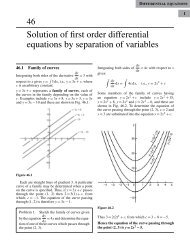vector
Create successful ePaper yourself
Turn your PDF publications into a flip-book with our unique Google optimized e-Paper software.
452 Vectors<br />
1. Use the Stoke’s Theorem to evaluate<br />
EXERCISE 5.14<br />
<br />
2<br />
ydx<br />
xydy xzdz,<br />
C<br />
where C is the bounding curve of the hemisphere x 2 + y 2 + z 2 = 1, z 0, oriented in the positive<br />
direction. Ans. 0<br />
2. Evaluate<br />
(curl F) ndA ˆ , using the Stoke’s Theorem, where F yiˆ<br />
zj ˆ xkˆ<br />
and s is the paraboloid<br />
s<br />
z = f (x, y) = 1 – x 2 – y 2 , z 0.<br />
Ans. <br />
<br />
2 2 2<br />
3. Evaluate the integral for ydx z dy xdz, where C is the triangular closed path joining the points<br />
C<br />
(0, 0, 0), (0, a, 0) and (0, 0, a) by transforming the integral to surface integral using Stoke’s Theorem.<br />
<br />
2<br />
4. Verify Stoke’s Theorem for A 3 yiˆ<br />
xzj ˆ yz kˆ<br />
, where S is the surface of the paraboloid 2z = x<br />
2<br />
+ y 2<br />
bounded by z = 2 and c is its boundary traversed in the clockwise direction.<br />
Ans. – 20 <br />
5. Evaluate<br />
F<br />
<br />
d R where<br />
C<br />
Ans.<br />
3<br />
a<br />
.<br />
3<br />
<br />
ˆ 3<br />
F yi xz ˆ j zy<br />
3ˆ k,<br />
C is the circl x 2 + y2 = 4, z = 1.5 Ans. 19 2 <br />
6. If S is the surface of the sphere x 2 + y 2 + z 2 <br />
= 9. Prove that curl F ds = 0.<br />
S<br />
7. Verify Stoke’s Theorem for the <strong>vector</strong> field<br />
<br />
F (2 y z) iˆ<br />
( x – z) ˆj ( y – x)<br />
kˆ<br />
over the portion of the plane x + y + z = 1 cut off by the co-ordinate planes.<br />
8. Evaluate <br />
dr by Stoke’s Theorem for F yziˆ zx ˆ j xyk and C is the curve of intersection of<br />
c<br />
x 2 + y 2 = 1 and y = z 2 . Ans. 0<br />
9.<br />
<br />
If ˆ 3 ˆ 2<br />
F ( x – z) i ( x yz) j 3xy kˆ<br />
and S is the surface of the cone z = a – 2 2<br />
( x y ) above the<br />
xy-plane, show that<br />
<br />
curl FdS = 3 a 4 / 4.<br />
s<br />
<br />
10. If F 3yiˆ<br />
xyj ˆ yz2kˆ<br />
and S is the surface of the paraboloid 2z = x 2 + y 2 bounded by z = 2, show by<br />
<br />
using Stoke’s Theorem that ( F)<br />
dS = 20 .<br />
s<br />
<br />
2 2 2 2 2 2 2 2 2<br />
11. If F ( y z – x ) iˆ<br />
( z x – y ) ˆj ( x y – z ) kˆ<br />
, evaluate curl F nds ˆ integrated over<br />
the portion of the surface x 2 + y 2 – 2ax + az = 0 above the plane z = 0 and verify Stoke’s Theorem; where<br />
ˆn is unit <strong>vector</strong> normal to the surface. (A.M.I.E.T.E., Winter 20002) Ans. 2 a 3<br />
where C is the boundary of<br />
C<br />
12. Evaluate by using Stoke’s Theorem sin zdx cos x dy sin<br />
ydz<br />
rectangle 0 x, 0 y1, z 3 . (AMIETE, June 2010)<br />
5.40 GAUSS’S THEOREM OF DIVERGENCE<br />
(Relation between surface integral and volume integral)<br />
(U.P., Ist Semester, Jan., 2011, Dec, 2006)<br />
Statement. The surface integral of the normal component of a <strong>vector</strong> function F taken around<br />
a closed surface S is equal to the integral of the divergence of F taken over the volume V enclosed<br />
by the surface S.<br />
Mathematically<br />
<br />
S<br />
<br />
F.<br />
nˆ<br />
ds <br />
<br />
V<br />
<br />
div Fdw










